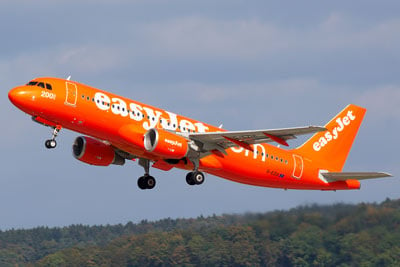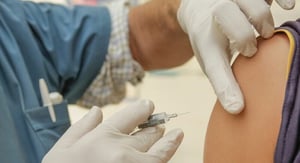easyJet Plc (LON:EZJ) has announced its trading update for the quarter ended 31 December 2024.
easyJet improves Q1 performance by 52% YoY
· Q1 headline loss before tax £61 million, an improvement of £65 million YoY
o Passenger growth +7% YoY
o ASK Capacity +11% YoY, with a sector length increase of 6% YoY
o RASK flat YoY, in line with guidance
o CASK ex fuel flat YoY, Fuel CASK reduced by 13% YoY driving total CASK down 4% YoY
o easyJet holidays delivered £43 million profit, +£12 million YoY
· H1 underlying winter losses expected to reduce when adjusted for the timing of Easter and a prior year release of aged balances
o H1 ASK Capacity +12% YoY (Q2 ASKs +14% YoY)
o Headline result impacted by Easter timing and a one off prior year release of aged balances. Q2 underlying unit revenue trends are modestly lower than Q1 due to our capacity investment on longer leisure flows. These are driving productivity and utilisation benefits this winter with route maturity benefits expected next winter and beyond
o Expect H1 headline CASK ex fuel to slightly reduce YoY
o Expect H1’25 fuel CASK to reduce by c.8% YoY, when factoring in current fuel spot price
· Positive outlook for FY25, consistent with consensus1, and on track to achieve medium term target of >£1bn PBT
o Expect FY25 ASK growth of c. 8% YoY
o easyJet holidays expects c.25% customer growth YoY
o Forward bookings; Q2 57% sold, +2ppts YoY; Q3 26% sold, +2ppts YoY; Q4 13% sold, +1ppt YoY
Overview
easyJet’s first quarter result significantly improved as demand for our primary airport network and package holidays continued, alongside cost control and favourable fuel prices. Six new A320neo family aircraft were delivered and taken into ownership in the quarter, a seventh aircraft was delivered in January and another two are expected to be operational by peak summer.
This winter’s underlying result will reflect Q1 improvements, partially offset by Q2 underlying unit revenue trends being modestly lower than Q1, as capacity investments (Q2 ASKs +14% YoY) are naturally requiring stimulation while driving productivity and utilisation benefits this winter with route maturity benefits expected next winter and beyond.
The traditionally busy Easter period is seeing strong demand and bookings continue to build for Summer 2025. At this early stage of the year, the current booking trends are supportive of FY25 consensus1. We remain focused and confident in the progress towards our medium term target of sustainably generating over £1 billion of profit before tax.
Kenton Jarvis, CEO of easyJet, commenting on the results said:
“easyJet performed well in the quarter reducing Q1 losses by 52% year on year while flying 7% more customers to an even greater choice of destinations across the network. easyJet holidays continued its growth, achieving around a 40% increase in profits during the period.
“Looking to this summer, we have seen continuing demand for easyJet’s flights and holidays where we have one million more customers already booked, with firm favourites like Palma, Faro and Alicante as well as new destinations like Tunisia and Cairo proving popular. All of this demonstrates positive progress towards our medium term target to deliver more than one billion pounds of profit before tax.”
We are the best ESG rated European airline from Sustainalytics (score of 21.4). We hold a best in class rating from CDP (A-) and MSCI (AA rating), and we also retain our position in FTSE4Good for a second year running. The efficiencies which we have ahead of us will only strengthen our position.
In the first quarter of FY25 easyJet signed a Memorandum of Understanding (MOU) and a Letter of Intent with Enlive and Moeve for the supply of sustainable aviation fuel (SAF) covering material requirements in Italy and Spain over the next 5 years, as we continue to drive progress on our net zero roadmap. In addition, we have signed a tri-party MoU with Renavia and World Fuel Services giving easyJet access to material volumes of advanced Bio and eSAF from 2030.
Outlook
· At this early stage of the year, current booking trends are supportive of FY25 consensus1.
· H1 underlying winter losses expected to reduce when adjusted for the timing of Easter and a prior year release of aged balances.
– Easter moving into Q3’25 (c.£30m) and the prior year release of aged balances (c.£34m). These combined are worth c.4ppts of RASK reduction YoY in Q2.
· Forward bookings; Q2 57% sold, +2ppts YoY; Q3 26% sold, +2ppts YoY; Q4 13% sold, +1ppt YoY
· H1’25 total CASK to reduce YoY
· easyJet holidays expects c.25% customer growth YoY
– Bookings; H1’25 is 93% sold & H2’25 is 45% sold
· Expect ASK capacity growth of c.8% in FY25
– FY25 Seat capacity growth expected to be c.3% YoY to c.103 million seats (H1 c.45 million, H2 c.58 million)
| YoY growth | ASK’s | Sector length | Seats |
| H1’25 | +12% | +6% | +6% |
| H2’25 | +5% | +5% | +1% |
| FY25 | +8% | +5% | +3% |
Fuel & FX Hedging
| Jet Fuel | H1’25 | H2’25 | H1’26 | USD | H1’25 | H2’25 | H1’26 | |
| Hedged position | 82% | 64% | 32% | Hedged position | 76% | 61% | 34% | |
| Average hedged rate ($/MT) | 807 | 770 | 755 | Average hedged rate (USD/GBP) | 1.26 | 1.27 | 1.28 | |
| Current spot ($/MT) at 20.01.25 | c.795 | Current spot (USD/GBP) at 20.01.25 | c.1.22 | |||||
Capacity
During Q1 easyJet flew 24.1 million seats. In the same period last year easyJet flew 23.0 million seats. Load factor was 88% (Q1 FY24: 86%).
Passenger numbers in the quarter increased to 21.2 million (Q1 FY24: 19.8 million).
| October 2024 | November 2024 | December 2024 | Q1FY25 | Q1FY24 | |
| Number of flights | 54,024 | 35,723 | 43,349 | 133,096 | 128,272 |
| Peak operating aircraft | 324 | 322 | 293 | 324 | 317 |
| Passengers (thousand) | 8,554 | 5,796 | 6,886 | 21,236 | 19,842 |
| Seats flown (thousand) | 9,704 | 6,491 | 7,877 | 24,072 | 22,994 |
| Load factor | 88.1% | 89.3% | 87.4% | 88.2% | 86.3% |
Financial Summary
| Q1’25 | Q1’24 | Variance favourable/ (adverse) | |
| Passenger revenue (£’m) | 1,255 | 1,133 | 11% |
| Airline ancillary revenue (£’m) | 535 | 486 | 10% |
| Holidays revenue2 (£’m) | 247 | 181 | 36% |
| Group revenue (£’m) | 2,037 | 1,800 | 13% |
| Fuel costs (£’m) | (500) | (516) | 3% |
| Airline headline EBITDA costs ex fuel (£’m) | (1,182) | (1,057) | (12)% |
| Holidays EBITDA costs2 (£’m) | (207) | (153) | (35)% |
| Group headline EBITDA costs (£’m) | (1,889) | (1,726) | (9)% |
| Group headline EBITDA (£’m) | 148 | 74 | 100% |
| Airline depreciation & amortisation (£’m) | (185) | (189) | 2% |
| Holidays depreciation & amortisation2 (£’m) | (3) | (2) | (50)% |
| Group headline LBIT (£’m) | (40) | (117) | 66% |
| Airline financing costs excluding balance sheet revaluations (£’m) | (19) | (10) | (90)% |
| Holidays financing costs (£’m) | 6 | 5 | 20% |
| Balance sheet revaluations (£’m) | (8) | (4) | (100)% |
| Group headline LBT (£’m) | (61) | (126) | 52% |
| Airline passenger RASK (p) | 4.16 | 4.16 | 0% |
| Airline ancillary RASK (p) | 1.77 | 1.79 | (1)% |
| Total airline RASK (p) | 5.93 | 5.95 | 0% |
| Total airline revenue per seat (£) | 74.36 | 70.39 | 6% |
| Airline headline CASK ex fuel (p) | (4.61) | (4.63) | 0% |
| Airline Fuel CASK (p) | (1.66) | (1.90) | 13% |
| Airline total headline CASK (p) | (6.27) | (6.53) | 4% |
| Airline total headline cost per seat (£) | (78.70) | (77.22) | (2)% |
| Sector length (km) | 1,255 | 1,182 | 6% |
| Available seat kilometres (ASK) (millions) | 30,213 | 27,190 | 11% |
| Cash and other cash investments (£’bn) | 2.8 | 1.9 | 47% |
| Net cash/ (debt) (£’m) * | (484) | (485) | 0% |
* Net debt is flat year on year due to the final delivery payments for the 22 aircraft delivered in the last 12 months (six in the current quarter) and pre-delivery payments for the future ramp up in aircraft deliveries.
1) Internally compiled consensus for FY25 Headline PBT is £709 million as at 22 January 2025.
2) easyJet holidays numbers include elimination of intercompany airline transactions




































